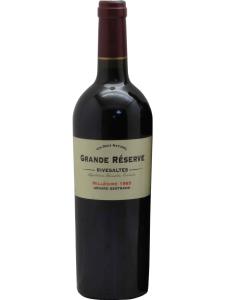Rivesaltes is an appellation for the historic sweet wines of eastern Roussillon, in the deep south of France. The sweet vin doux naturel wines produced in this area have been revered since at least the 14th Century. The technique used to make them is one of several employed for sweet wines. Unlike botrytized wines or ice wines, vins doux naturels are made by mutage, a process of stopping must fermenting while there is still a high level of natural sweetness. With their high levels of residual sugar (a minimum of 100 g/l) and alcohol (between 15% and 17% ABV), these wines are sweet and relatively viscous.
Understandably, Rivesaltes wines are often confused with Muscat de Rivesaltes wines, which are similar in style and come from the same area. The key difference is that Muscat de Rivesaltes is produced from Muscat grapes, while Rivesaltes is made from Grenache of all three forms (Noir, Blanc and Gris).
Rivesaltes wines are produced in several forms, distinguished by their colors (the result of the grape varieties and ageing processes used to make them). These are Rosé, Grenat, Ambré and Tuilé. There is a fifth category, Hors d'Age, which can be claimed only by Ambre and Tuile wines aged for at least five years before release onto the market.
Rivesaltes Rosé wines are much fresher and fruitier than their longer-aged counterparts. After just three months' ageing in glass containers, they are often on the market in time for the Christmas after harvest. They are made with a high proportion of Grenache Noir, and are the only Rivesaltes wines that show any high level of varietal character.
Rivesaltes Ambre wines are made predominantly from Grenache Blanc, Grenache Gris, Maccabeu and Tourbat, with a smaller amount (20%) of Muscat Blanc or Muscat of Alexandria also permitted. Subjected to a minimum of two years' oxidative ageing, they are deep golden-yellow in their youth, with aromas of sweet nuts and caramelized citrus fruits. As they age, the gold color deepens and moves towards orange, amber and eventually reddish-brown.
Rivesaltes Grenat wines are bottled much earlier than their counterparts, but are still aged for a minimum of nine months. Deep ruby red in color, they are made from at least 75% Grenache Noir (just like their Banyuls Grand Cru counterparts produced near the border with Spain). Being less oxidatively aged, they retain their intense, sweet, red-berry aromas.
Rivesaltes Tuile wines are made from 50% Grenache Noir. They are aged for two years, during which their original deep ruby color takes on elements of gold and tawny and their red-berry aromas develop into those of coffee, chocolate and confected fruits. They are similar in style to Banyuls Rouge.
The official Rivesaltes viticultural area covers 85 parishes (effectively the eastern third) of the Pyrenees-Orientales administrative departement. It also includes a further nine parishes in the neighboring Aude departement, thus overlapping the southern edge of the Fitou and Minervois vineyard zones. This is France's largest sweet-wine-producing area. The only difference between the Muscat de Rivesaltes and Rivesaltes production zones is that the latter does not cover the villages of Cerbere, Collioure, Port-Vendres and Banyuls-sur-Mer, on the coast right by the Spanish border. The simple reason for this is that these villages already have their own very distinctive, Grenache-based sweet wine, Banyuls.


